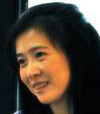About the Presenters
PANEL 1/In Terms of Love
Beverly Bossler
Love, Desire, Romance: Interrogating Terminology
 Beverly Bossler is professor of history and chair of the East Asian Languages and Cultures Department at University of California, Davis. Her research focuses on social, intellectual, and gender history of China in Middle Period China (Tang, Song, Yuan). She is the author of "Powerful Relations" (1998) and "Courtesans, Concubines, and the Cult of Female Fidelity in China, 1000-1400" (2013), and the editor of "Gender & Chinese History: Transformative Encounters" (2015).
Beverly Bossler is professor of history and chair of the East Asian Languages and Cultures Department at University of California, Davis. Her research focuses on social, intellectual, and gender history of China in Middle Period China (Tang, Song, Yuan). She is the author of "Powerful Relations" (1998) and "Courtesans, Concubines, and the Cult of Female Fidelity in China, 1000-1400" (2013), and the editor of "Gender & Chinese History: Transformative Encounters" (2015).
Abstract:
In his 2012 book, "The Making of Romantic Love," the renowned historian of emotion William Reddy argued that only in Europe was sexual desire understood as a physical appetite, separate from the spiritual or sacred realm (Reddy 2012). Reddy’s main thesis is that the Western concept of romantic love developed as a response or "resistance" to church medieval doctrine, which posited all carnal desire as evil and opposed to spiritual progress. The ideal of romantic love served to "recuperate" or rehabilitate sexual desire as part of a spiritual love, different from "animal lust."
Although we may not fully agree with Reddy’s characterization of the uniqueness of the European case, his work reminds us that we cannot take the meaning of terms like "love," "desire," and "romance' for granted. What were the various valences of terms used to describe love and desire in Tang and Song China? What factors contributed to the development of the new culture of romance develop in the mid-late Tang dynasty? How were various types of love depicted in the written sources of the period.
My talk will trace the shifting understandings of various terms for Chinese terms for love and sexual desire in Tang and Song China, and analyze how "love," "desire," and "romance" were expressed and understood in the context of Chinese social life in the period.
Eugene Wang
How Much Does a Chinese Hairpin Weigh?
 Eugene Wang is Abby Aldrich Rockefeller Professor of Asian Art at the Department of History of Art and Architecture, Harvard University. His book, "Shaping the Lotus Sutra: Buddhist Visual Culture in Medieval China" (2005) has received the Academic Achievement Award in memory of the late Professor Nichijin Sakamoto, Rissho University, Japan. He is the art history associate editor of the "Encyclopedia of Buddhism" (New York, 2004). His 30 or so articles published in The Art Bulletin, Art History, Critical Inquiry, Res: Journal of Anthropology and Aesthetics, Public Culture, and elsewhere, cover a wide range of subjects, including ancient bronze mirrors, Buddhist murals and sculptures, reliquaries, scroll paintings, calligraphy, woodblock prints, architecture, photography, and films. He has also translated Roland Barthes’ "Fragments d’un discours amoureux" into Chinese, and wrote the screenplay for a short film, Stony Touch, selected for screening in the 9th Hawaii International Film Festival.
Eugene Wang is Abby Aldrich Rockefeller Professor of Asian Art at the Department of History of Art and Architecture, Harvard University. His book, "Shaping the Lotus Sutra: Buddhist Visual Culture in Medieval China" (2005) has received the Academic Achievement Award in memory of the late Professor Nichijin Sakamoto, Rissho University, Japan. He is the art history associate editor of the "Encyclopedia of Buddhism" (New York, 2004). His 30 or so articles published in The Art Bulletin, Art History, Critical Inquiry, Res: Journal of Anthropology and Aesthetics, Public Culture, and elsewhere, cover a wide range of subjects, including ancient bronze mirrors, Buddhist murals and sculptures, reliquaries, scroll paintings, calligraphy, woodblock prints, architecture, photography, and films. He has also translated Roland Barthes’ "Fragments d’un discours amoureux" into Chinese, and wrote the screenplay for a short film, Stony Touch, selected for screening in the 9th Hawaii International Film Festival.
PANEL 2/Moral Pleasures
Julia K. Murray
Duty and Desire in Chinese Paintings and Prints
 Julia K. Murray is professor emerita of art history, East Asian studies, and religious studies at the University of Wisconsin, and associate in research at the Fairbank Center for Chinese Studies at Harvard University. She previously worked in curatorial positions at the Metropolitan Museum of Art, Freer Gallery of Art, and Harvard Art Museum. Her books include "Mirror of Morality: Chinese Narrative Illustration and Confucian Ideology" (2007; Chinese edition 道 德 镜 鉴 : 中 国 叙 述 性 图 画 与 儒 家 意 识 形 态 , 2014); "Confucius: His Life and Legacy in Art" (with Wensheng Lu, 2007); "Stone Sculptures in the Abby Aldrich Rockefeller Garden" (1994); "Ma Hezhi and the Illustration of the Book of Odes" (1993); "Last of the Mandarins" (1987); and "A Decade of Discovery" (1979). She has published numerous journal articles and chapters on wide-ranging topics in Chinese pictorial art and narrative illustration. Her current research focuses on the visual and material culture associated with the veneration of Confucius, including its contemporary resurgence.
Julia K. Murray is professor emerita of art history, East Asian studies, and religious studies at the University of Wisconsin, and associate in research at the Fairbank Center for Chinese Studies at Harvard University. She previously worked in curatorial positions at the Metropolitan Museum of Art, Freer Gallery of Art, and Harvard Art Museum. Her books include "Mirror of Morality: Chinese Narrative Illustration and Confucian Ideology" (2007; Chinese edition 道 德 镜 鉴 : 中 国 叙 述 性 图 画 与 儒 家 意 识 形 态 , 2014); "Confucius: His Life and Legacy in Art" (with Wensheng Lu, 2007); "Stone Sculptures in the Abby Aldrich Rockefeller Garden" (1994); "Ma Hezhi and the Illustration of the Book of Odes" (1993); "Last of the Mandarins" (1987); and "A Decade of Discovery" (1979). She has published numerous journal articles and chapters on wide-ranging topics in Chinese pictorial art and narrative illustration. Her current research focuses on the visual and material culture associated with the veneration of Confucius, including its contemporary resurgence.
Abstract:
Most premodern Chinese paintings that are generally considered mainstream uphold what might loosely be called "Confucian" values, which emphasize the individual's obligations within a hierarchical network of reciprocal relationships. Within this framework, women were assigned subordinate roles and expected to support the interests of the family over their own feelings and aspirations. Didactic illustrations reinforced the message by depicting women serving their husbands and parents-in-law or tending to children. Men could have multiple wives and pursue romantic relationships, and many paintings show elite males enjoying the attention of anonymous females. However, unusually beautiful women were often identified as goddesses, with whom a liaison was portrayed as inevitably frustrating or even dangerous. Excessive indulgence in female companionship could even lead to catastrophe, as in the case of Tang emperor Minghuang and Yang Guifei, the audience for the generically beautiful musicians in the Worcester handscroll. Such paintings and their literary sources are typically interpreted as allegories, bringing out moral-political cautionary meanings accepted as orthodox morality. Paintings of this type were preserved for centuries, in catalogue records if not in actuality.
By contrast, many late Ming woodblock-printed illustrated drama and fiction celebrated romantic relationships, particularly between young scholars and beautiful maidens. Catering to the viewer's private enjoyment instead of promoting moral guidance, some pictures went beyond the merely suggestive to portray explicit erotica. But official disapproval imperiled the survival of such productions, whose artistic merits gained recognition only in the 20th century, when scholars and critics began to question traditional values as China modernized.
Pauline Lee
“There is nothing more…than dressing and eating”: Li Zhi (李贄), Desire, and Ethics
 Pauline Lee 李博鈴 is an associate professor of Chinese Religions and Cultures at Saint Louis University. She received her A.B. (English Literature, 1991) from Stanford University, her M.T.S. (Comparative Religions, 1995) from Harvard Divinity School, and her Ph.D. (Religious Studies, 2002) from Stanford University. She teaches East Asian religions and philosophy with courses in Chinese thought, Confucianism, Daoism, Buddhism, East Asian women and feminisms, Chinese Civilization, world religions, East-West comparative thought, and children’s studies. Her first monograph, "Li Zhi, Confucianism, and the Virtue of Desire" (State University of New York Press, 2012), examines the 16th-century Chinese iconoclast Li Zhi and his views on the role of self-expression and desire in a good life. In the Journal of Chinese Religions, Dao: A Journal of Comparative Philosophy, the Journal of Chinese Philosophy, and edited volumes on women and Chinese thought she has published in the areas of Chinese feminisms, space and place, Chinese conceptions of childhood, and comparative religions and philosophy. With Rivi Handler-Spitz and Haun Saussy, she has co-edited "A Book to Burn and A Book to Keep (Hidden)" (Columbia UP, 2016), the first English-language volume of essays on this major thinker. Her current major project, provisionally entitled "Play in China: The Trifling, the Wicked, and the Sacred," examines changing views of play in China through a study of religious and philosophical classics, commentaries on these works, as well as paintings and playthings.
Pauline Lee 李博鈴 is an associate professor of Chinese Religions and Cultures at Saint Louis University. She received her A.B. (English Literature, 1991) from Stanford University, her M.T.S. (Comparative Religions, 1995) from Harvard Divinity School, and her Ph.D. (Religious Studies, 2002) from Stanford University. She teaches East Asian religions and philosophy with courses in Chinese thought, Confucianism, Daoism, Buddhism, East Asian women and feminisms, Chinese Civilization, world religions, East-West comparative thought, and children’s studies. Her first monograph, "Li Zhi, Confucianism, and the Virtue of Desire" (State University of New York Press, 2012), examines the 16th-century Chinese iconoclast Li Zhi and his views on the role of self-expression and desire in a good life. In the Journal of Chinese Religions, Dao: A Journal of Comparative Philosophy, the Journal of Chinese Philosophy, and edited volumes on women and Chinese thought she has published in the areas of Chinese feminisms, space and place, Chinese conceptions of childhood, and comparative religions and philosophy. With Rivi Handler-Spitz and Haun Saussy, she has co-edited "A Book to Burn and A Book to Keep (Hidden)" (Columbia UP, 2016), the first English-language volume of essays on this major thinker. Her current major project, provisionally entitled "Play in China: The Trifling, the Wicked, and the Sacred," examines changing views of play in China through a study of religious and philosophical classics, commentaries on these works, as well as paintings and playthings.
Abstract:
In this talk I examine the writings of the great Ming period Confucian and iconoclast Li Zhi 李贄 (hao: Zhuowu 卓吾) (1527-1602) and argue that he articulates a coherent and compelling vision of a good life focused on the expression of genuine desires distinctive to each individual. Through a study of literary texts and terms of art he refers to in his iconic essay "On the Child-like Heart-mind" (Tongxin shuo 童心說), as well as the metaphors and images he fleshes out throughout his writings, I characterize Li’s ethical vision and show that it is rooted in a particular loose and accommodating conception of human nature and centered on the simple and intuitive act of daily maintaining the birthright of our "child-like heart-mind."
PANEL 3/ Subversive Entertainments
Linda Rui Feng
An Urban Topography of Desire: The Pingkang Pleasure Quarters in the Tang Capital
 Linda Rui Feng is associate professor of premodern Chinese cultural studies at the Department of East Asian Studies, University of Toronto. She is the author of the monograph "City of Marvel and Transformation: Chang’an and Narratives of Experience in Tang Dynasty China" (2015), which explores the connections among urban space, literati networks, and narrative formation in the century following the reign of the "Bright Emperor." Her current project examines how writers of medieval China rendered geographical knowledge through both text and image, as well as some of the sources of its efficacy, as seen through the use of maps.
Linda Rui Feng is associate professor of premodern Chinese cultural studies at the Department of East Asian Studies, University of Toronto. She is the author of the monograph "City of Marvel and Transformation: Chang’an and Narratives of Experience in Tang Dynasty China" (2015), which explores the connections among urban space, literati networks, and narrative formation in the century following the reign of the "Bright Emperor." Her current project examines how writers of medieval China rendered geographical knowledge through both text and image, as well as some of the sources of its efficacy, as seen through the use of maps.
Abstract:
Anecdotal collections from the second half of the Tang dynasty, with narratives that revolve around events in the annual civil service examination, point to an urban network of highly evaluative, consumptive, and performative relationships in the capital of Chang’an. This is especially true for anecdotes about the demimonde in the Pingkang Ward located in the northeastern quadrant of the capital city and at the intersection between sexual commerce and a highly visible examination culture. Although these anecdotes are steeped with desire, they are neither wholly carnal nor divine; instead, they offer glimpses into a world of narrow alleys, chanted gossip, and savvy transactions among the highly literate courtesans and literati aspirants, both of whom participate in an ubiquitous circuit in which reputations were made and unmade.
Paola Zamperini
Monkeying Around: Aliens and Lovers in Late Imperial Chinese Fiction
 Paola Zamperini is a professor of pre-modern Chinese literature and gender and sexuality studies at Northwestern University, where she is the founding chair of the Department of Asian Languages and Cultures. Her research and teaching interests span pre-modern Chinese literature, gender studies, Chinese history, fashion theory, Chinese and Tibetan Buddhism, and contemporary Chinese fiction, cinema, and popular culture. She has written and published extensively about prostitution, female suicide, pornography and spiritual resonance in pre-modern Chinese literature.
Paola Zamperini is a professor of pre-modern Chinese literature and gender and sexuality studies at Northwestern University, where she is the founding chair of the Department of Asian Languages and Cultures. Her research and teaching interests span pre-modern Chinese literature, gender studies, Chinese history, fashion theory, Chinese and Tibetan Buddhism, and contemporary Chinese fiction, cinema, and popular culture. She has written and published extensively about prostitution, female suicide, pornography and spiritual resonance in pre-modern Chinese literature.
Abstract:
From very early on in the history of Chinese literature, narratives engaged with the tropes of the alien and the strange in their dual role of dangerous presence and exotic attraction. Foreigners, supernatural creatures, animals, and immortals crowd the pages of many stories that have travelled through centuries and genres to consistently entertain their audiences while engaging, albeit in different fashions and across different literary genres, with the implications that the presence of alien creatures in the lives of characters generated.
Aiming to join this very rich but still much understudied arena, this paper focuses on the recently rediscovered eighteenth century work Guwang yan 姑妄言, ‘Preposterous Words’, as a primary example of the ways in which strangers, be they fantastic creatures, women, and other protagonists, enter the circuit of narratives of desire and virtue in late imperial Chinese fiction. Using the theoretical and analytical tools of gender studies, literary and critical theory, we shall uncover how characters perform, embody, challenge, and shed the identity as strangers throughout the course of this protean and surreal novel.
PANEL 4/ Staging Desire
Patricia Sieber
Imperial Desire, Song-Drama, and the Printed Image in Ming Editions of the Yuan zaju Rain on the Wutong Tree
 Patricia Sieber (Ph.D. University of California, Berkeley) is an associate professor in the Department of East Asian Languages and Literatures at the Ohio State University. Her research interests encompass Chinese song and song-drama, print culture, and visual culture from the Yuan and the Ming periods. She is the author of "Theaters of Desire: Authors, Readers, and the Reproduction of Early Chinese Song-Drama, 1300-2000" and of many essays on the reception history of Chinese literature in China and in early modern Europe. She is currently the lead editor for "How To Read Chinese Drama," an anthology of essays designed to traditional Chinese theater to a broad readership.
Patricia Sieber (Ph.D. University of California, Berkeley) is an associate professor in the Department of East Asian Languages and Literatures at the Ohio State University. Her research interests encompass Chinese song and song-drama, print culture, and visual culture from the Yuan and the Ming periods. She is the author of "Theaters of Desire: Authors, Readers, and the Reproduction of Early Chinese Song-Drama, 1300-2000" and of many essays on the reception history of Chinese literature in China and in early modern Europe. She is currently the lead editor for "How To Read Chinese Drama," an anthology of essays designed to traditional Chinese theater to a broad readership.
Abstract:
This presentation will focus on the images accompanying the zaju version of the story of Emperor Xuanzong and Precious Consort Yang entitled "Rain on the Wutong Tree" in Zang Maoxun’s (1550-1620) definitive edition of so-called Yuan zaju, the Yuanqu xuan (Refined selections of Yuan song-dramas, 1615/16). Much has been written about Zang’s systematic rewriting of the plays found in his anthology. However, much less has been said about how the 200 or so images prominently placed in the opening segment of the anthology may have interacted with Zang’s interpretation of particular plays. Nor has much effort been expended to show how these pictures related to and resonated with the visual culture before and after their time. In order to investigate such text/image relations in greater detail, the presentation will examine how Zang’s Rain on the Wutong Tree engages with scene selection, iconography, and inscriptions. In order to decode how these images in the Yuanqu xuan speak to visual culture more broadly, we will compare them with related pictures found in other late imperial imprints, single sheet prints, and decorative media.
Joseph Lam
Singing and Dancing Desire on China's Kunqu stage
 Joseph S. C. Lam is professor of musicology at the University of Michigan. He is a music historian who currently chairs the Department of Musicology and serves as the Director of the Stearns Collection of Musical Instruments. His research interests include: theories of ethnomusicology, theories of music historiography, ritual and music, traditional Chinese music, traditional Japanese music, and Asian American concert music. His publications include "Kunqu, the Classical Opera of Globalized China" (forthcoming), "Historical Studies on Song Dynasty Music: Theories and Narratives" (in Chinese, 2012), and "State Sacrifices and Music in Ming China: Creativity, Orthodoxy and Expressiveness" (1998).
Joseph S. C. Lam is professor of musicology at the University of Michigan. He is a music historian who currently chairs the Department of Musicology and serves as the Director of the Stearns Collection of Musical Instruments. His research interests include: theories of ethnomusicology, theories of music historiography, ritual and music, traditional Chinese music, traditional Japanese music, and Asian American concert music. His publications include "Kunqu, the Classical Opera of Globalized China" (forthcoming), "Historical Studies on Song Dynasty Music: Theories and Narratives" (in Chinese, 2012), and "State Sacrifices and Music in Ming China: Creativity, Orthodoxy and Expressiveness" (1998).
Abstract:
Confucian China accepts love and desire as fundamental expressions of humanity, but demands that they be exercised with neither excess nor vulgarity. Confucius declared that ya (civilized and refined) expressions of love and desire, such as "Guanju/Guanguan cry the Osprey" in the "Shijing (Classic of Poetry)," are entertaining without being licentious. Among all kinds of performance of Chinese stories and emotions, kunqu (kun opera) is historically considered most ya and most expressive. This paper presents three examples of kunqu singing and dancing of desire, which are namely the zhezixi (theatrical scenes) of "Xiaoyan ("Palace Garden Party") from the Palace of Everlasting Live (Changshengdian), "Qintiao" ("Zither Seductions" from the Jade Hairpin (Yuzanji), and "Jiaqi ("Auspicious Time") from The Story of the West Chamber (Xixiangji). Analysis of the scenes will demonstrate how the plays evoke desire/sex with opaque words, suggestive choreography, and revealing singing. To casual audience, performances of the plays appear innocent; to connoisseurs, the performances are as sexy as can be—all erotic words, sounds, and sights are sophisticated "masked" by ya performance practices.

